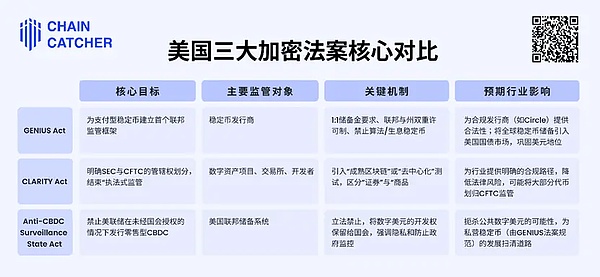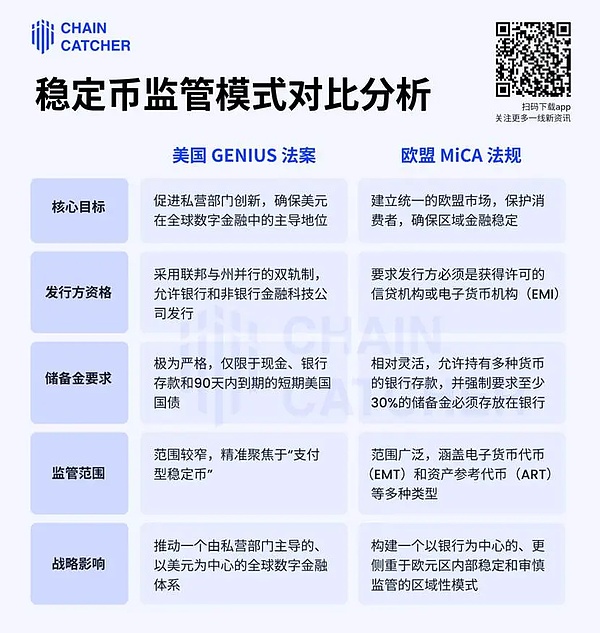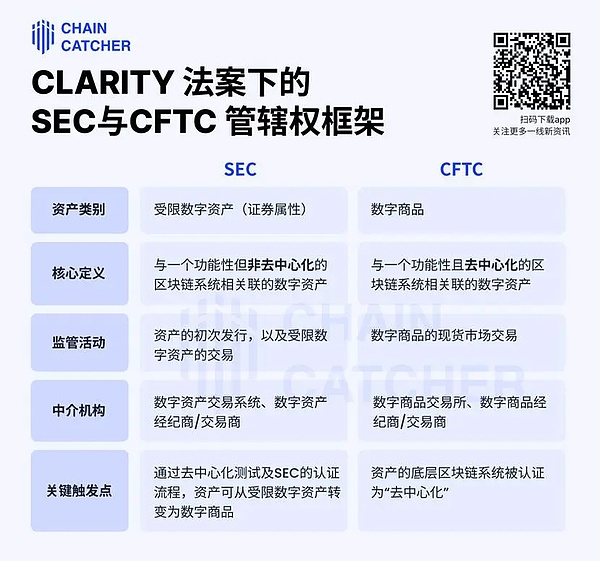CLARITY Act:
Provide clear market rules for other digital asset transactions
Reduce regulatory uncertainty and reduce project compliance risks
Provide clearer legal boundaries for digital asset innovation

GENIUS Act: The digital new clothes of the US dollar hegemony
The Act requires all stablecoin issuers to obtain federal or state licenses and hold US dollar cash, bank deposits or short-term US Treasury bonds as reserves at a 1:1 ratio. This means that behind every stablecoin held by users, there is an equivalent amount of US dollar assets to support it, greatly improving the security of funds.
For users, the most important changes include: algorithmic stablecoins will be explicitly banned, and a two-year transition period will be given, which means that projects like Terra/Luna will not be able to operate in the United States. Stablecoins will not be able to pay interest to holders, and users will need to look for other DeFi protocols to earn returns.
The Act is actually a financial strategic layout of the United States. By forcing stablecoin reserves to hold US dollar assets, it is estimated that by 2028, $1.6 trillion of the global $2 trillion stablecoin market will flow into US short-term Treasury bonds, further consolidating the dollar's dominance in the digital world.
The bill has a far-reaching impact on the industry landscape. Compliant U.S. issuers such as Circle will be the biggest winners. Its CEO Jeremy Allaire has repeatedly expressed support, believing that the bill can formally incorporate stablecoins into the U.S. financial system and become "cash equivalents" on corporate balance sheets, thereby opening the door to institutional adoption.
In contrast, small or non-compliant issuers will face huge compliance costs and survival pressures, and the market may see further consolidation. Foreign issuers must also meet strict registration and regulatory requirements if they want to enter the U.S. market. Although the bill has received broad bipartisan support in the Senate, some Democrats are still concerned about the strength of its consumer protection and national security provisions.
CLARITY Act: Delineating the "Boundary Between the SEC and the CFTC"
The U.S. crypto industry has long been plagued by regulatory uncertainty. The jurisdictional dispute between the SEC and the CFTC, as well as the SEC's "enforcement-style supervision" strategy, have made the entire industry tread on thin ice. The SEC insists on using the "Howey test" from the 1940s to determine whether digital tokens are securities, which not only stifles innovation and hinders the development of the entire industry, but also triggers legal battles such as the SEC suing Coinbase. The CLARITY Act is designed to put an end to this chaos.
The core innovation of the bill is the introduction of the concept of "mature blockchain system". The basic logic is that digital assets may be regulated by the SEC as "investment contract assets" in the initial financing stage, but as the network becomes sufficiently decentralized, they can be transformed into "digital commodities" and regulated by the CFTC.
The key criteria for judging whether a blockchain system is "mature" include: no entity holds more than 20% of the tokens, and the value of the project mainly comes from actual use rather than speculation. This means that truly decentralized mature projects will have a more relaxed regulatory environment. This actually formally writes the "sufficient decentralization" theory into law.

According to the bill, the SEC is mainly responsible for the initial issuance of digital assets and the "maturity" certification review, while retaining the anti-fraud law enforcement power. The CFTC will obtain exclusive jurisdiction over "digital commodities", including the spot market. The CFTC will become the main regulator of the crypto market, and its regulatory style is generally more pragmatic and innovation-friendly than the SEC. This means that Web3 projects may have more room for development.
Web3 projects will have a clear "graduation path" - transitioning from securities regulation to commodity regulation, providing legal certainty for long-term development. When users trade mature digital assets, they will face a more friendly regulatory environment and reduce the risk of being suddenly identified as "unregistered securities."
This framework brings unprecedented certainty to the industry. Industry giants such as Coinbase and a16z have expressed their support, believing that this is the legal clarity needed for the development of the industry. For users, this means that when participating in Web3 applications such as DeFi and NFT, there will be clearer compliance guidelines and more stable regulatory expectations.
Anti-CBDC Bill: An Ideological Battle on "Financial Freedom"
The Anti-CBDC Surveillance State Act is the most ideological of the three bills. The content is simple and direct: the Federal Reserve is prohibited from issuing retail-oriented central bank digital currencies (CBDCs) without explicit authorization from Congress.
This means that the United States will not launch an official digital currency like China's digital RMB. The promoters of the bill are worried that CBDC may become a "government-controlled programmable currency", allowing the government to monitor, censor, and even restrict every transaction of users, which is in direct conflict with the core concept of Web3 decentralization and privacy protection.
The bill is actually protecting the Web3 ecosystem from direct competition from the government. If the Federal Reserve issues a CBDC, it may pose a major threat to Bitcoin, Ethereum, and various DeFi protocols, as users may prefer to use the "official" digital dollar.
Democrats oppose the bill, believing that it will weaken the United States' ability to innovate in finance, but for web3, the passage of the bill means that cryptocurrencies and DeFi protocols will continue to develop in a relatively free environment without having to worry about direct competition from official digital currencies.
The passage of the bill will ensure that the future of the digital dollar is dominated by the private sector - that is, through stablecoins regulated by the GENIUS Act. This is a double-edged sword for Web3 users: on the one hand, it avoids direct government control and maintains decentralized characteristics; on the other hand, stablecoins still need to follow strict supervision, which may limit the space for innovation.
Say goodbye to wilderness, embrace regulation
The rapid advancement of this series of bills is the result of years of game and cooperation between the US political circles, capital and the crypto industry. Faced with the EU MiCA Act and the active layout of Hong Kong and other places, the United States is trying to regain the dominance in the field of digital finance through a combination of punches.
The House Financial Services Committee, driven by key figures such as Patrick McHenry, successfully turned the crypto policy from partisan controversy to national consensus. The bill has won the support of a large number of Democrats in the House of Representatives, showing a fundamental change in the attitude of the US political circles towards the Web3 industry.
The crypto industry has evolved from a technical geek to a powerful political lobbying force. Companies led by Coinbase have invested heavily in supporting pro-crypto political action committees. Its CEO Brian Armstrong and the advocacy organization Stand With Crypto have actively lobbied lawmakers and successfully packaged industry demands into issues of protecting consumers and encouraging innovation. Circle, with its compliance image, showed legislators how regulated stablecoins can serve the financial interests of the United States.
At the same time, top venture capital institutions such as a16z and think tanks such as Coin Center and DeFi Education Fund provided theoretical foundations and specific legal provisions for the bill, profoundly influencing the final form of legislation. This indicates that the political operation of the crypto industry has become "professionalized" and can influence the legislative process.

The passage of this series of bills marks the beginning of a new era. The "Wild West" era of the crypto industry is gradually coming to an end. As the price of legal certainty and market legitimacy, the entire ecosystem will be formally incorporated into the existing financial regulatory framework. Stablecoin issuers will become buyers of U.S. Treasury bonds, and digital asset projects must operate within the framework defined by the SEC and CFTC.
This is an important trade-off: the industry cedes some freedom of innovation in exchange for a clear development space in the world's largest market. The United States, through standardized management, transforms Web3 technology into a new tool to consolidate its financial dominance. The "Clarity moment" of regulation has arrived, which means greater security, but may also face fewer innovation options and higher compliance costs.
 Hui Xin
Hui Xin
 Hui Xin
Hui Xin Jasper
Jasper Davin
Davin Aaron
Aaron Joy
Joy Hui Xin
Hui Xin Jasper
Jasper Jasper
Jasper Jixu
Jixu Hui Xin
Hui Xin